The Long Service Celebration honours employees and professional staff who have 5, 10, 15, 20, 25, 30, 35 and 40 years of service with Thunder Bay Regional Health Sciences Centre and Thunder Bay Regional Health Research Institute.
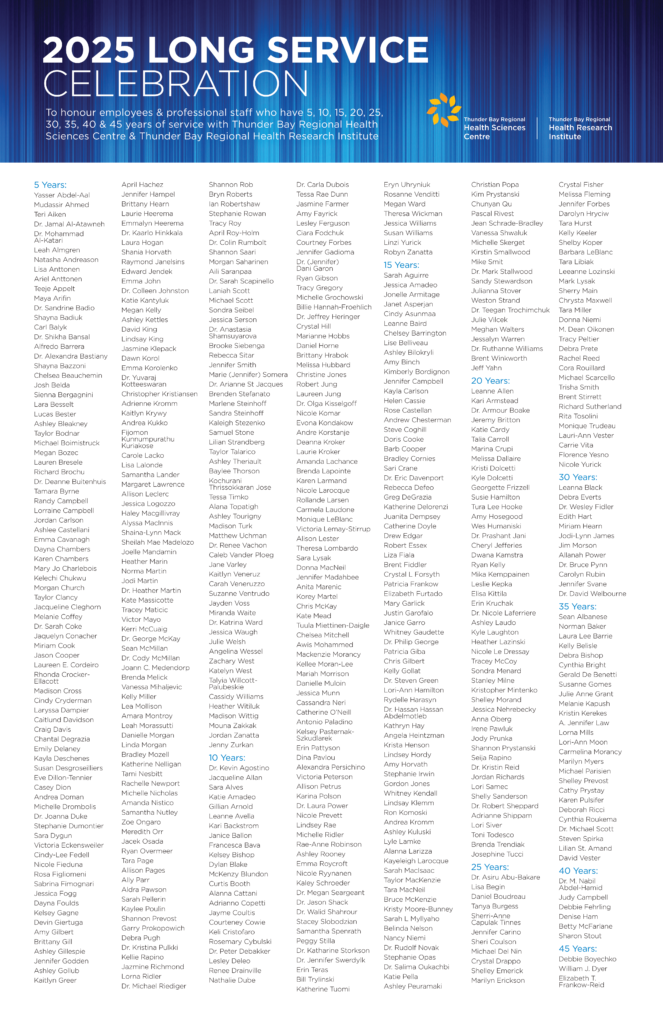

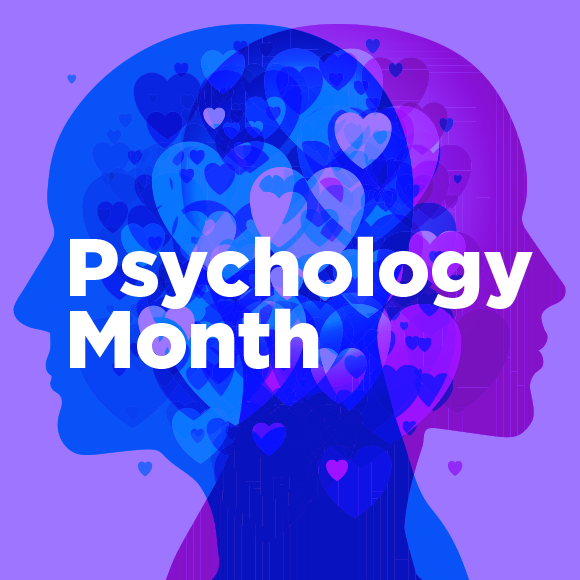
February is Psychology Month. Psychology is rooted in science that seeks to understand our thoughts, feelings and actions. It is a broad field – some psychology professionals develop and test theories through research while others work to help individuals, organizations, and communities function better. Still others are both researchers and practitioners.
Psychology Month is celebrated every February to highlight the contributions of Canadian psychologists and to show Canadians how psychology works to help people live healthy and happy lives, help their communities flourish, help their employers create better workplaces, and help their governments develop effective policies. Please join us in thanking the Psychologists and Psychological Associates who work at our Hospital and serve our community.
Learn more about Psychology Month by visiting https://cpa.ca/psychologymonth/ (via the Canadian Psychological Association)


Shared on behalf of John Ross, Code Blue/Pink/NRP Executive Sponsor, Director, Surgical and Ambulatory Services
The Hospital’s Code Blue/Pink/NRP – Cardiac Arrest Response (Adult, Child, Neonate) (EMER-140) policy has been revised.
Actions required:
Policy changes:
Process Reminders:
If you have any questions, please reach out to Mēsha Richard, Lead, Emergency Preparedness (ext. 6552 or mesha.richard@tbh.net)
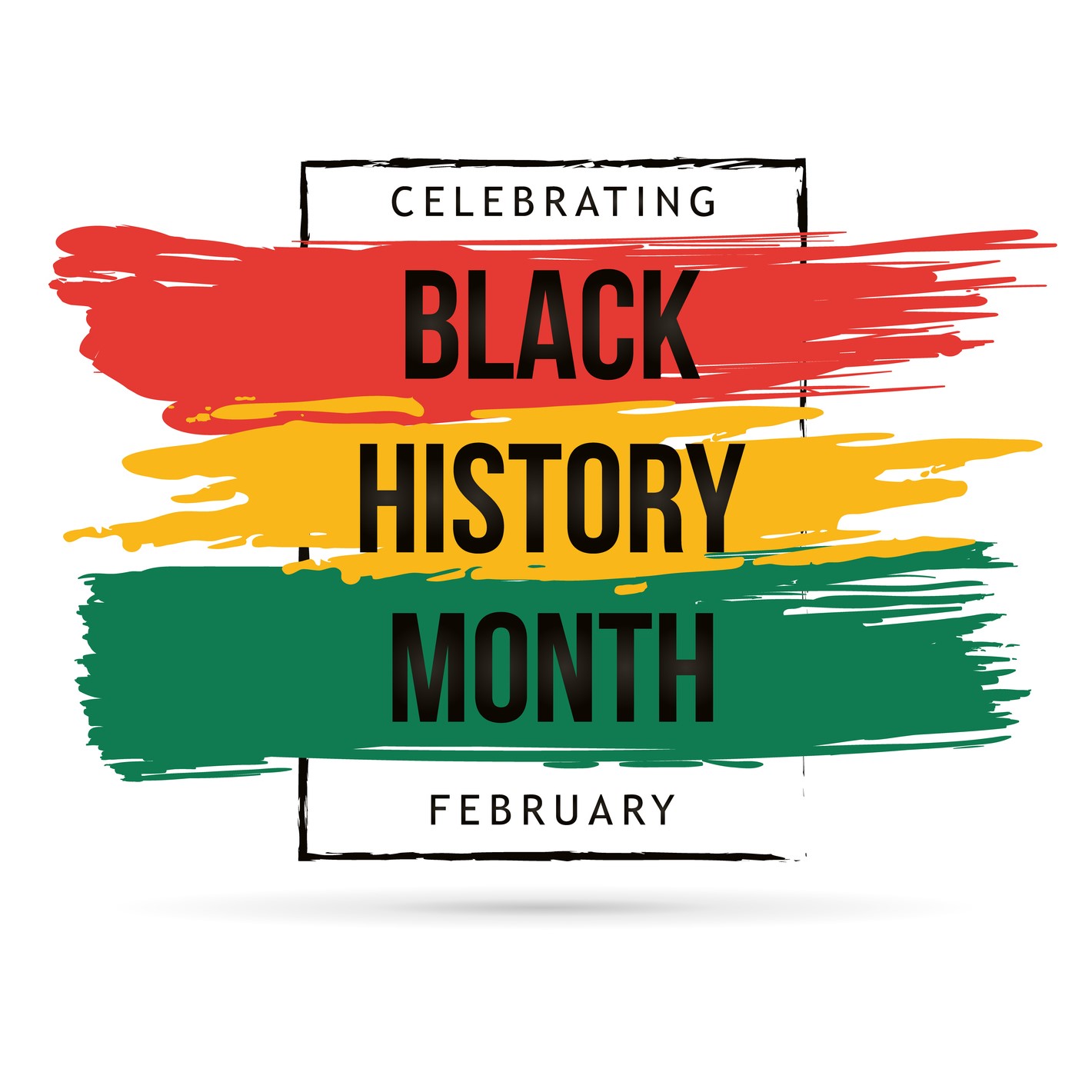
In honor of Black History Month, we recognize and celebrate the invaluable contributions of Black Canadians to the health care sector. Their resilience in the face of adversity, including racism and unequal opportunities, has empowered them to break barriers and achieve remarkable milestones. These trailblazers became pioneers in their respective fields, driving significant advancements in healthcare and social justice within their communities, while also paving the way for future generations.
Below, we highlight the biographies of Bernice Redmon and Clotilda Douglas-Yakimchuk, who made notable contributions to nursing; Dr. Sophia Bethena Jones, the first Canadian to earn a medical degree; and Dr. George Phills, a psychologist whose work significantly impacted the well-being of children and families.
Bernice Redmon (nee Carnegie) was born in Toronto on October 28, 1917. She made history as the first Canadian-born Black registered nurse, and the first Black nurse to be employed by the Victorian Order of Nurses (V.O.N.).
Her nursing journey was not without its challenges, as Canadian nursing schools in the 1940s did not admit Black students. In response, Bernice moved to the United States, where she earned her nursing degree from the St. Philips School of Nursing in Virginia. Demonstrating remarkable academic ability, she excelled in her studies and was awarded a scholarship to pursue an additional year of training, specializing in public health nursing.
Bernice graduated in 1945; she returned to Canada that same year, where she began her career with the Nova Scotia Department of Health, becoming the first Black nurse to practice in public health. Her ground-breaking work in the field opened doors for Black women to work and train in Ontario hospitals starting in the late 1940s and 1950s.
To learn more about Bernice Redmon, please go to: https://www.bernicecarnegie.com/carnegie-family

Clotilda Douglas-Yakimchuk was born and raised in Whitney Pier, Nova Scotia. In 1954, she made history as the first Black individual to graduate from the Nova Scotia Hospital School of Nursing. She went on to earn post-graduate diplomas in midwifery from Colony Hospital, Grenada, West Indies; and adult education from St. Francis Xavier University; as well as a post-graduate certificate in psychiatric nursing from the Nova Scotia Hospital.
Throughout her distinguished 50-year career in nursing, Clotilda served in various roles, including as a staff nurse, nursing supervisor, and Director. She also held the esteemed position of President of the Registered Nurses’ Association of Nova Scotia (now The College of Registered Nurses of Nova Scotia), and was the only elected Black President in the college’s 100-year history.
Beyond her nursing career, Clotilda was a passionate community advocate and a proponent of lifelong learning. She was the founding President of the Black Community Development Organization, an organization that championed causes such as affordable housing and improvements to seniors’ living facilities. Clotilda also played a key role in advocating for the establishment of a nursing degree program at Cape Breton University.
Clotilda retired from nursing in 1994. In recognition of her lifetime of activism and exceptional service to her community and the nursing profession, she was appointed to the Order of Canada in 2003, the Order of Nova Scotia in 2018, and received an honorary Doctorate of Laws from Cape Breton University in 2010.
To learn more about Clotilda Douglas-Yakimchuk, please go to: https://museumofhealthcare.blog/black-history-month-clotilda-douglas-yakimchuk/
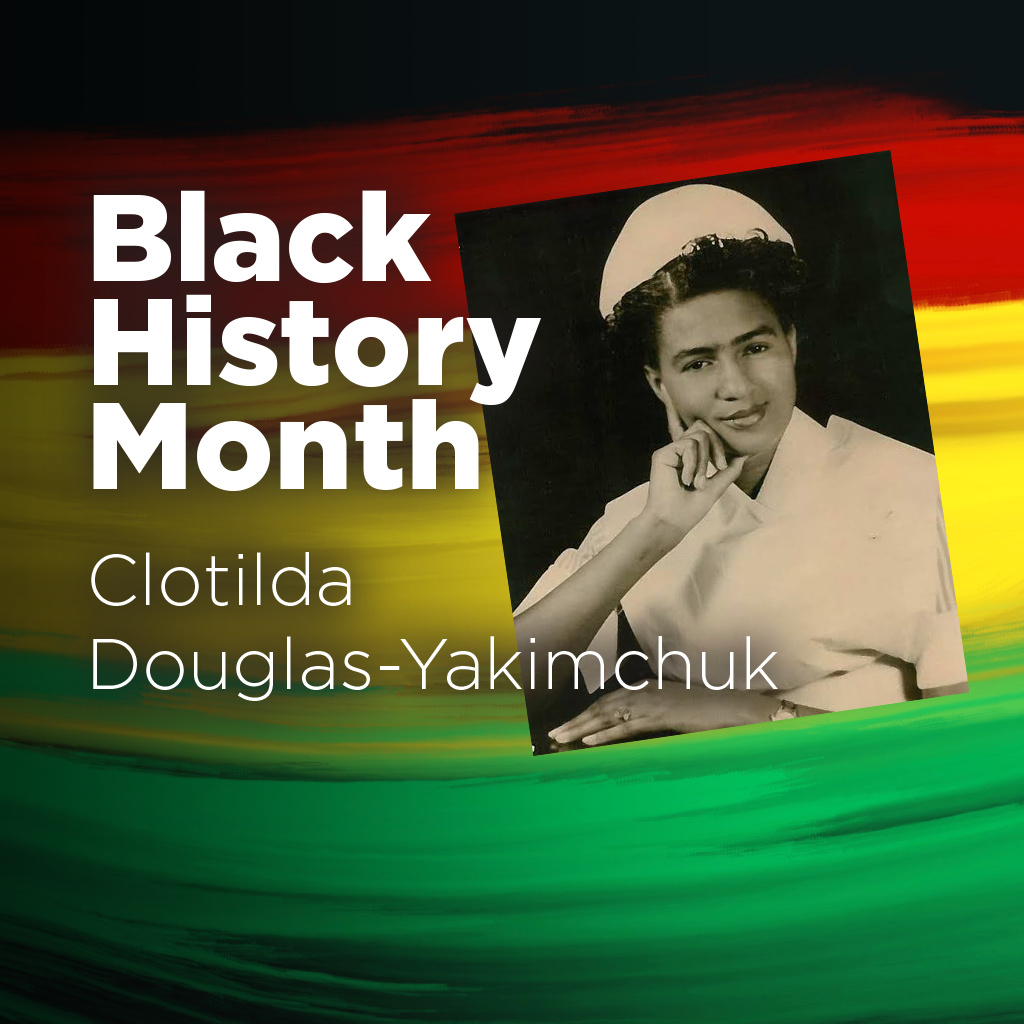
Dr. Sophia Bethena Jones was born in Chatham, Ontario, on May 6, 1857. Her parents were involved in the Canadian abolitionist movement, and their activism was said to have inspired Dr. Jones’ to forge a path for women in the medical field.
In 1879, Dr. Jones began studying Biology at the University of Toronto; however, due to pervasive racism and sexism, she was denied the opportunity to continue her studies at the university’s medical school. Undeterred, she pursued her dream of becoming a physician and was accepted into the University of Michigan Medical School in 1880. In 1885, Dr. Jones made history as the first Black woman to graduate from the school with a medical degree. Dr. Jones also holds the distinction of being the first Black Canadian to earn a medical degree.
Dr. Jones went on to teach medicine at Spelman College in Atlanta, Georgia as the first Black faculty member. She then continued her medical practice across the United States.
Dr. Jones was also a pioneer in medical research, being one of the first Black women to publish in the field. Her influential research, “Fifty Years of Negro Public Health,” was published in the Annals of the American Academy of Political and Social Science in September 1913. In this work, she highlighted the health disparities within Black communities, the long-term effects of intergenerational trauma from slavery, and advocated for equity in healthcare for all.
To learn more about Dr. Sophia Jones, please go to: https://museumofhealthcare.blog/black-history-month-dr-sophia-bethena-jones/

Dr. George Phills was a distinguished Black psychologist who dedicated his life to serving his community and improving the well-being of children. Born in Sydney, Nova Scotia to Mary Alda Phills and Isaac Phills, Dr. Phills’ parents instilled in him the values of family, community, education, and perseverance from an early age. He pursued higher education at King’s College in Halifax, earned a Master’s in Clinical Psychology from Dalhousie University, and obtained a PhD in Clinical Social Psychology from the University of London in England.
Following the completion of his studies, Dr. Phills returned to Sydney, where he headed a child guidance clinic. He later moved to London, Ontario, where he embarked on a 22-year long career with the London Board of Education—initially as a Consulting Psychologist and later, as Chief Psychologist. Dr. Phills developed several programs throughout his tenure, including the Early Identification Process, the Social Skills Project, and the Tragic Event Response Team. In addition to his professional work, Dr. Phills supported individuals facing family challenges and systemic racism, served on the boards of numerous mental health organizations in London, taught at Western University, and was instrumental in establishing the Ontario College of Psychology.
Dr. Phills’ outstanding contributions to both his profession and his community were recognized through numerous prestigious awards, including the Bea Wicket Award (1990), the Frank Brennan Award (1995), and the Distinctive Service Award from the London and Region Psychological Association (1996). To learn more about Dr. George Phills, please go to: https://www.canada.ca/en/canadian-heritage/campaigns/black-history-month/black-canadians.html#s6
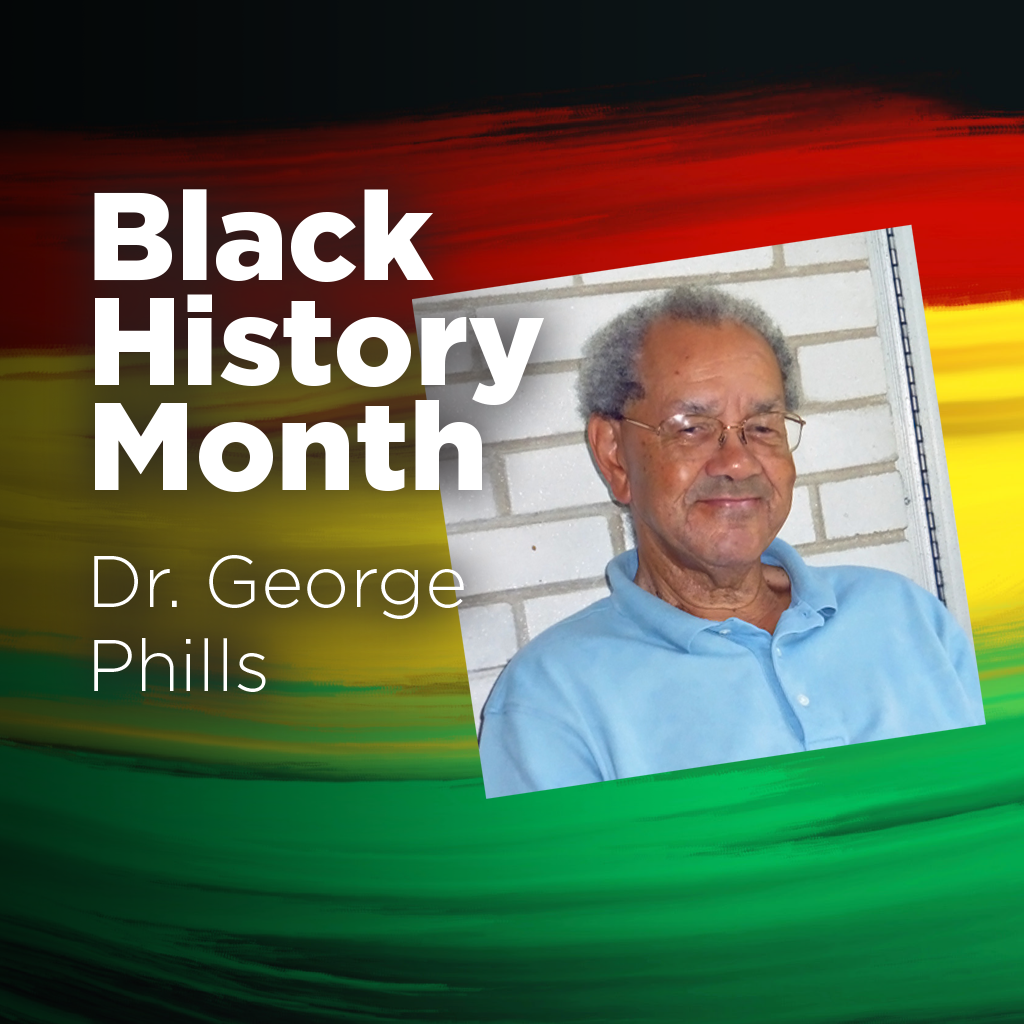
If you have any questions, or would like to provide feedback related to equity, diversity, and inclusion, please contact Rae-Anne Robinson, Equity, Diversity & Inclusion Coordinator at rae-anne.robinson@tbh.net, or the Equity, Diversity, and Inclusion Steering Committee at tbrhsc.edisteeringcommittee@tbh.net.

Afonso Creations’ Pocket Hug Fundraiser is still going! Pocket Hugs are $5, and succulents are $20, with part of the proceeds supporting the Northern Cardiac Fund.
Upcoming Sales:
Stop by and grab a thoughtful gift while supporting a great cause!


Good Catch Awards highlight individuals, groups or departments who demonstrate their commitment to keeping patients safe by reporting a near miss. A ‘good catch’ (or near miss) is an event or situation that could have resulted in harm, but did not reach the patient because of chance or timely intervention. Reporting these events can help to identify gaps in order to prevent future adverse events from happening.
Karen was working in the Cancer Centre when she received a dose of carboplatin at the Pharmacy with an incorrect label. The dose was not within 10% of the calculated dose and would, therefore, be unsafe to administer. An independent double-check was completed with another nurse. Karen then called the pharmacist to request that the chemotherapy be remixed to ensure proper dosing and labelling. Great catch!
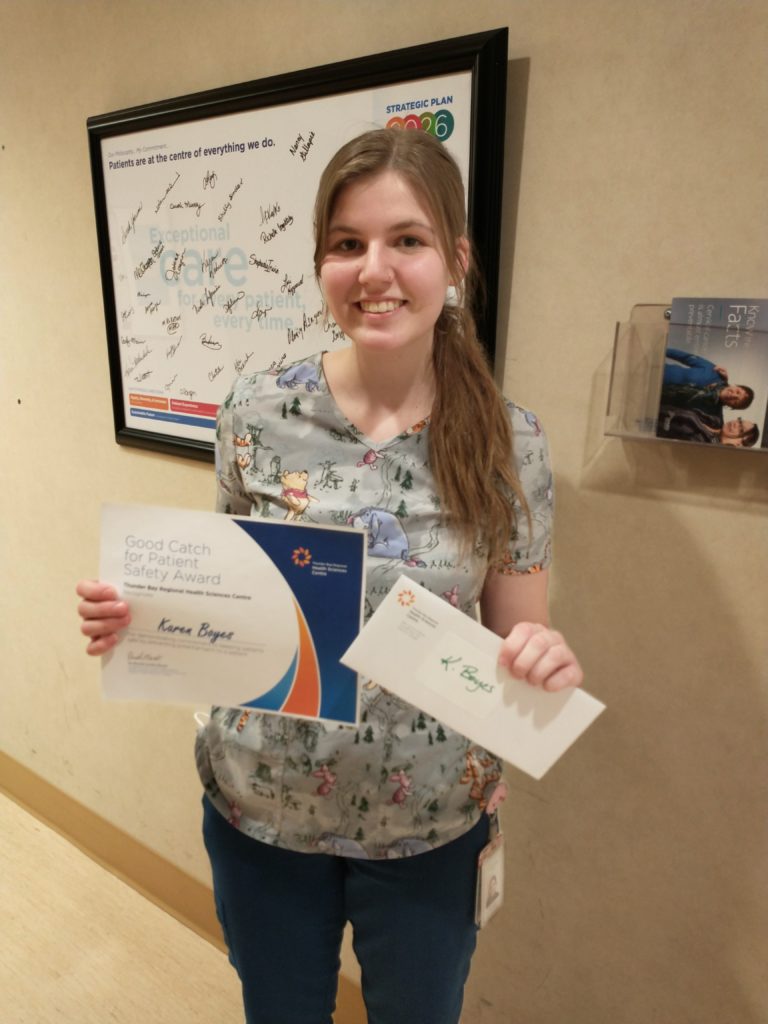
While working on 2C, day nurse Chelsea followed a physician’s orders to discontinue oxygen and discharge a patient home. However, it was noted that the patient still required oxygen. Chelsea completed a walking test without oxygen, and the patient continued to desaturate, after which she notified the physician. This led to the discharge being put on hold until RT could re-assess. It was determined that the patient qualified for home oxygen. Chelsea used great nursing judgment in advocating for a delayed discharge. Good initiative!
Thank you to both for your diligence and dedication to safety! Each recipient has been awarded a certificate and gift cards to local businesses.
New winners will be selected every quarter. Continue submitting your near misses for a chance to win! Near miss reports are submitted through the Incident Learning System (patient safety incidents). Click on the ‘safety reporting’ icon from your Novell home page, or go to the iNtranet and choose ‘Safety Reporting’ under ‘Informational’.
For more information, contact Terry Fodë, Patient Safety Improvement Specialist (terry.fode@tbh.net).

Shared on behalf of Jeannine Verdenik, Vice President People and Culture
As part of our ongoing commitment to safety, we are pleased to announce the distribution of new safety lanyards that adhere to the latest safety standards. These lanyards feature a 3-way breakaway mechanism, which is essential for ensuring safety.
Key Points:
1. Distribution of New Lanyards:
New lanyards will be provided to Leadership for distribution to all staff, volunteers, and learners based on their primary department, during the week of February 24, 2025.
Going forward, lanyards will be distributed during general orientation/on-boarding by the responsible department:
2. Discontinuation of Retractable Reels:
Effective immediately, we will discontinue the use of all retractable reels. These may pose a safety risks and therefore do comply with our new standards.
3. Removal of Non-Compliant Lanyards:
Additionally, all lanyards that do not meet the 3-way breakaway safety standard must be removed from use.
We will update our dress code and related policies and identify procedures for replacement of lost or damaged lanyards to ensure an accessible and efficient method for all team members.
We appreciate your cooperation in this important matter. Ensuring a safe working environment is a shared responsibility, and your adherence to these new standards is crucial.
If you have any questions or concerns, please feel free to contact Human Resources or Occupational Health and Safety.


This month’s Town Hall took place on Wednesday, February 19 at 2:00 p.m. See below for a video recording of the session and a copy of the presentation slides.
If you have questions you would like answered, please send them to TBRHSC.GroupNews@tbh.net and we will do our best to address them at a future Town Hall.
If you’d like to access a recording or presentation from a previous Town Hall, visit the archive.
Thank you for your commitment to staying informed and engaged.

Presented by: Dr. Akos Kazinczi & Dr. Birbui Biman
When: Tuesday March 4, 2025
Time: 4:30 p.m. – 5:30 p.m.
Meeting number: 2335 131 3561
Password: Meeting
“The Department of Internal Medicine Monthly Rounds is a self-approved group learning activity (Section 1) as defined by the Maintenance of Certification Program of the Royal College of Physicians and Surgeons of Canada.”
Article:

In recognition of Black History Month, we encourage you to explore the works of influential Black writers and activists. These powerful narratives offer insight into the struggles and resilience of Black communities throughout history, as well as the ongoing pursuit of equity and social justice. By engaging with these voices, both during Black History Month and throughout the year, we can deepen our understanding of Black history and culture, while honoring those who have shaped it.
If you have any questions, or would like to provide feedback related to equity, diversity, and inclusion, please contact Rae-Anne Robinson, Equity, Diversity & Inclusion Coordinator at rae-anne.robinson@tbh.net, or the Equity, Diversity, and Inclusion Steering Committee at tbrhsc.edisteeringcommittee@tbh.net.
How to be Antiracist – Ibram X. Kendi
In his memoir, Kendi weaves together an electrifying combination of ethics, history, law, and science–including the story of his own awakening to antiracism–bringing it all together in a cogent, accessible form. https://www.cdnsba.org/wp-content/uploads/2020/11/Reading-on-Anti-Racism-for-Trustees.pdf
So You Want To Talk About Race – Ijeoma Oluo
In So You Want to Talk About Race, Ijeoma Oluo guides readers of all races through subjects ranging from police brutality and cultural appropriation to the model minority myth in an attempt to make the seemingly impossible possible: honest conversations about race, and about how racism infects every aspect of American life. https://www.amazon.ca/You-Want-Talk-About-Race/dp/1580056776#:~:text=In%20So%20You%20Want%20to,infects%20every%20aspect%20of%20American
The New Jim Crow: Mass Incarceration in the Age of Colorblindness – Michelle Alexander
Seldom does a book have the impact of Michelle Alexander’s The New Jim Crow. Since it was first published in 2010, it has been cited in judicial decisions and has been adopted in campus-wide and community-wide reads; it helped inspire the creation of the Marshall Project and the new $100 million Art for Justice Fund; it has been the winner of numerous prizes, including the prestigious NAACP Image Award; and it has spent nearly 250 weeks on the New York Times bestseller list. https://thenewpress.com/books/new-jim-crow
Caste: The Origins of Our Discontents – Isabel Wilkerson
Beyond race, class, or other factors, there is a powerful caste system that influences people’s lives and behavior and the nation’s fate. Linking the caste systems of America, India, and Nazi Germany, Isabel Wilkerson explores eight pillars that underlie caste systems across civilizations, including divine will, bloodlines, stigma, and more. https://www.nationalbook.org/books/caste-the-origins-of-our-discontents/
Me and White Supremacy: Combat Racism, Change the World, and Become a Good Ancestor – Layla Saad
Updated and expanded from the original workbook (downloaded by nearly 100,000 people), this critical text helps you take the work deeper by adding more historical and cultural contexts, sharing moving stories and anecdotes, and including expanded definitions, examples, and further resources, giving you the language to understand racism, and to dismantle your own biases, whether you are using the book on your own, with a book club, or looking to start family activism in your own home. https://apps.asha.org/eweb/OLSDynamicPage.aspx?Webcode=olsdetails&title=Me+and+White+Supremacy+
The Fire Next Time – James Baldwin
The book includes two essays that were written in the 1960s during a time of segregation between White and Black Americans. In his essays, Baldwin’s purpose was to reach a mass white audience and help them to better understand Black Americans’ struggle for equal rights. https://en.wikipedia.org/wiki/The_Fire_Next_Time
Read This to Get Smarter About Race, Class, Gender, Disability, & More – Blair Imani
An approachable guide to being an informed, compassionate, and socially conscious person today—from issues of race, gender, and sexual orientation to disability, class, and beyond—from critically acclaimed historian, educator, and author. https://www.goodreads.com/book/show/57663076-read-this-to-get-smarter
The 1619 Project – Nikole Hannah-Jones
The 1619 Project, published by the New York Times, retells the history of the U.S. by foregrounding the arrival 401 years ago of enslaved Africans to Virginia. Through a series of essays, photos, and podcasts, The 1619 Project charts the impact of slavery on the country’s founding principles, economy, health care system, racial segregation of neighborhoods and schools, popular music and visual representations. Conversations around The 1619 project have served as a flashpoint for intensive ideological debates about its content and impact. It has been both widely lauded and subjected to critiques from academics, journalists, pundits and policymakers who challenge its accuracy and its interpretation of history. https://www.humanities.uci.edu/humanitiescenter/1619-project
Between the World and Me – Ta-Nehisi Coates
Between the World and Me is Ta-Nehisi Coates’s attempt to answer these questions in a letter to his adolescent son. Coates shares with his son—and readers—the story of his awakening to the truth about his place in the world through a series of revelatory experiences, from Howard University to Civil War battlefields, from the South Side of Chicago to Paris, from his childhood home to the living rooms of mothers whose children’s lives were taken as American plunder. Beautifully woven from personal narrative, reimagined history, and fresh, emotionally charged reportage, Between the World and Me clearly illuminates the past, bracingly confronts our present, and offers a transcendent vision for a way forward. https://ta-nehisicoates.com/books/between-the-world-and-me/
A Love Letter to Africville – Amanda Carvery-Taylor
A Love Letter to Africville is a dazzling compilation of personal stories and photos from former residents of Africville. Much has been written about the struggles of the Africville community, who have been hurt, discriminated against and dispossessed for so long – but Africville is so much more than just the pain. This book recasts the historical narrative to help former residents heal by emphasizing the beautiful and positive aspects of Africville. Amanda Carvery-Taylor organizes captivating stories and stunning photography that express the love and importance of Africville. This book is a warm hug from one of Canada’s most important storied communities. https://www.cbc.ca/books/a-love-letter-to-africville-1.5896839
The Sweetness of Water – Nathan Harris
In the spirit of The Known World and The Underground Railroad, a profound debut about the unlikely bond between two freedmen who are brothers and the Georgia farmer whose alliance will alter their lives, and his, forever. In the waning days of the Civil War, brothers Prentiss and Landry—freed by the Emancipation Proclamation—seek refuge on the homestead of George Walker and his wife, Isabelle. The Walkers, wracked by the loss of their only son to the war, hire the brothers to work their farm, hoping through an unexpected friendship to stanch their grief. Prentiss and Landry, meanwhile, plan to save money for the journey north and a chance to reunite with their mother, who was sold away when they were boys. https://www.goodreads.com/book/show/54404602-the-sweetness-of-water
The Book of Negroes – Lawrence Hill
Abducted as a child from her village in West Africa and forced to walk for months to the sea, Aminata Diallo is sent to live as a slave in South Carolina. But years later, she forges her way to freedom, serving the British in the Revolutionary War, registering her name in the historic “Book of Negroes” and eventually travelling back to Africa. A sweeping story that transports the reader from a tribal African village to a plantation in the southern United States, from the teeming Halifax docks to the manor houses of London, The Book of Negroes introduces one of the strongest female characters in Canadian fiction, one who cuts a swath through a world hostile to her colour and her sex. https://www.lawrencehill.com/the-book-of-negroes
Song of Solomon – Toni Morrison
Song of Solomon, the first African American novel since Native Son to be a Book-of-the-Month Club main selection, blends African American folklore, history, and literary tradition to celebrate the moral and spiritual revival of Macon Dead, the first male protagonist in a Morrison novel, via the guidance and example of his aunt Pilate, another of Morrison’s unconventional, soul-liberating heroines. https://www.britannica.com/art/African-American-literature/Renaissance-in-the-1970s#ref793894
Girl, Woman, Other – Bernardine Evaristo
Teeming with life and crackling with energy — a love song to modern Britain and black womanhood. Girl, Woman, Other follows the lives and struggles of twelve very different characters. Mostly women, black and British, they tell the stories of their families, friends and lovers, across the country and through the years. Joyfully polyphonic and vibrantly contemporary, this is a gloriously new kind of history, a novel of our times: celebratory, ever-dynamic and utterly irresistible. https://www.goodreads.com/book/show/41081373-girl-woman-other
Transcendent Kingdom – Yaa Gyasi
Yaa Gyasi’s Transcendent Kingdom, one of the most anticipated novels of 2020, delivers an intimate portrayal of a Ghanaian family making its way in the contemporary American South, a story as multifaceted as the human brain itself. For Gyasi to write a novel strong enough to follow her highly acclaimed debut Homegoing, she had to create the diamond that is Transcendent Kingdom. https://therumpus.net/2021/02/03/transcendent-kingdom-by-yaa-gyasi/
Americanah – Chimamanda Ngozi Adichie
There are some novels that tell a great story and others that make you change the way you look at the world. Chimamanda Ngozi Adichie’s Americanah is a book that manages to do both. It is ostensibly a love story – the tale of childhood sweethearts at school in Nigeria whose lives take different paths when they seek their fortunes in America and England – but it is also a brilliant dissection of modern attitudes to race, spanning three continents and touching on issues of identity, loss and loneliness. https://www.theguardian.com/books/2013/apr/15/americanah-chimamanda-ngozi-adichie-review